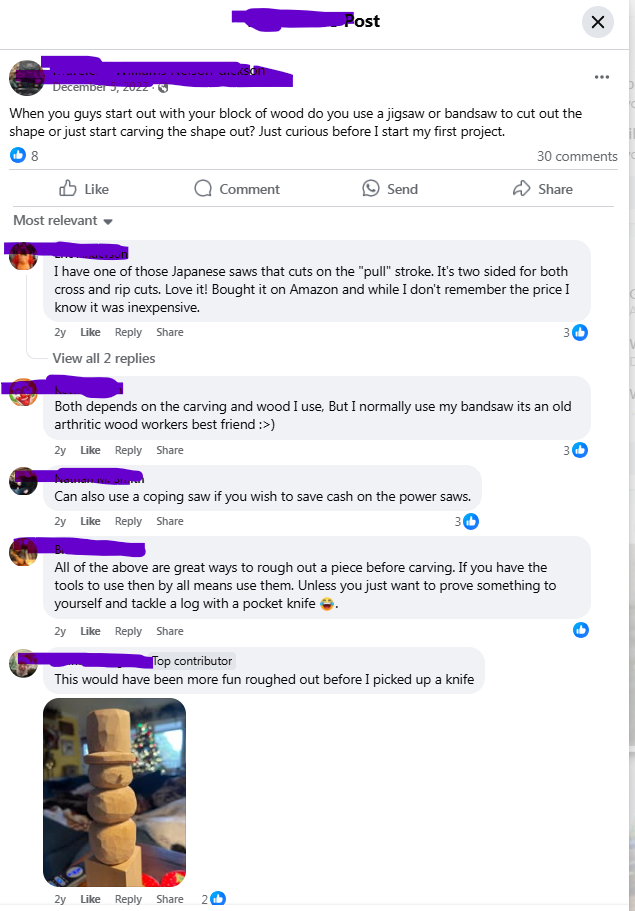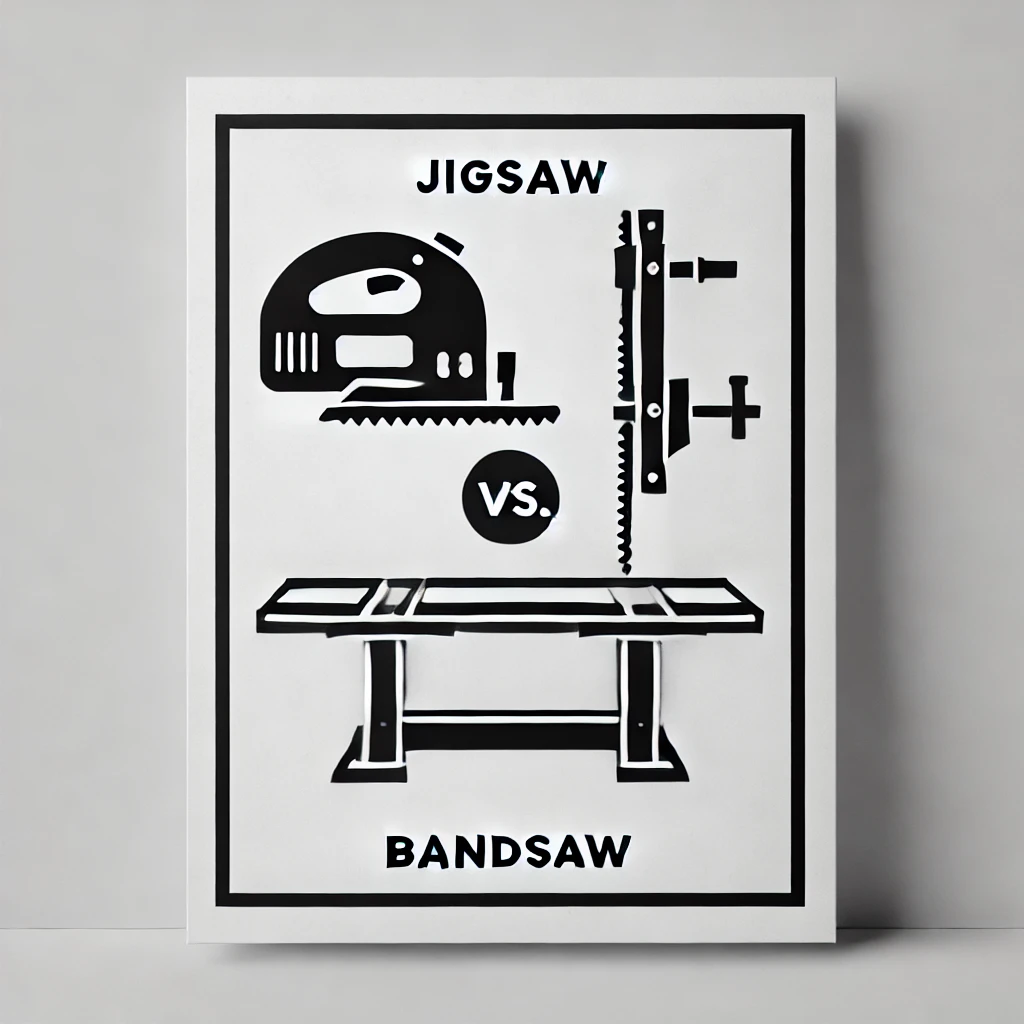While jigsaws and bandsaws are commonly thought to perform identical tasks, they are not interchangeable. The two saws are purposely designed to take on distinct projects, with the latter mostly used for re-sawing and other heavy duty tasks, while the former is mostly used for making curved cuts on thin materials.
In this piece, we will take a deep dive into the exact nature of jigsaws and bandsaws to establish which is best suited for your woodworking journey.
Jigsaw
A jigsaw, also known as a bayonet or saber saw, is a handheld power tool fitted with a reciprocating blade used to make a variety of cuts on thin materials. Notably, you can choose between a corded or cordless jigsaw. This tool has a motor fitted in its head to which the blade (which is mostly around 5 inches long) is attached and a bottom base shoe where the jigsaw rests on the wood surface.
Using a Jigsaw
Once the shoe is set on the work-piece, you are required to press the trigger which in turn powers on the motor and causes the blade to move up and down as it cuts through the wood. In this case, the blade uses upstroke motion to cut through the material.
A major drawback of this cutting mechanism is the high risk of the blade rasping against the material as it moves up and down. This leads to high vibrations and increases the rate of blade wear and tear.
Fortunately, most advanced jigsaw models have an orbital action option wherein the blade moves in an elliptical motion. This means the blade tilts back slightly on the down stroke, thus minimizing vibrations and wear and tear.
Notably, a jigsaw does not have a back plate and its blade is relatively small. Therefore, it has not limit on its cutting area capacity and is capable of making intricate cuts at odd angles, preferably on thin materials.
Pros and Cons of Using a Jigsaw
| Pros | Cons |
|---|---|
| More ideal for fine detail cuts Easy to use Ideal for cutting from the middle More affordable Portable and convenient | Limited visibility due to reciprocating blade Limited to cutting thin materials Faster rate of blade wear and tear Less control |
Bandsaw
On the opposite end of this debate is the bandsaw, which is more of an industrial machine that uses a continuous loop blade to cut various materials ranging from wood to meat.
It features two huge wheels, one positioned on top of the other, each with a diameter of around one foot. A bandsaw blade, which features welded endpoints, is fitted around the wheels, creating a continuous loop. As such, the blade moves in a single downward direction when cutting through materials.
Using a Bandsaw
Once the motor starts running, the material is placed on the table top and cautiously passed through the rotating blade. This way, you are guaranteed a consistent cut since the only thing that moves during cutting is the work-piece being cut. However, it is important to set the blade tension accordingly to ensure it is held tight for a precise and controlled cut.
This continuous downward loop is highly beneficial as it ensures sawdust drops underneath the material, allowing for enhanced cutting visibility. Moreover, the constant motions reduce machine vibration for increased cutting accuracy.
Pros and Cons of Using a Bandsaw
| Pros | Cons |
|---|---|
| More powerful Controlled and precise cutting More visibility due to downward cutting | More complicated setup due to blade fitting Less ideal for fine detail cuts More costly Regular maintenance |
Jigsaw VS. Bandsaw
Price
If you are on a tight budget, then the jigsaw is your best bet. Its price is a fraction of what you will spend on a regular bandsaw.
Visibility
With its reciprocating blade action, a jigsaw tends to kick up a lot of sawdust which in turn gets in the way of effective and precise cutting.
On the flip side, this is not a problem with the band saw as its continuous downward blade loop ensures most of the sawdust is kicked downwards below the working surfacing, adding to the process’s visibility.
1. Tool Comparison & Buying Guides
Directly relevant, high-authority internal pages:
- Best Jigsaw for Beginners
- Best Bandsaw for Woodworking
- Best Scroll Saw for Intricate Cuts
- Best Table Saw for Small Workshops
- Best Chainsaw for Wood Carving
Functionality
Bandsaws are mostly used for re-sawing; cutting large lumber along the grain to create smaller pieces, as well as other heavy-duty tasks. This is not only due to its powerful, consistent cutting motion, but also its backstop which limits its use to larger-sized timber. Its powerful motion enables the bandsaw to cut through thicker lumber pieces more consistently and quickly, while the backstop and circular blade motion add to its cutting consistency due to repeated similar motions. You are more likely to get a consistent finish with the bandsaw than a jigsaw.
It is a different case for jigsaws as they do not have a backstop and have a significantly smaller blade. As such, the absence of a back plate means there is no maximum cutting area capacity. You might as well start cutting your board from the middle if your intended pattern calls for this. However, its limited power, small blade and possibility of blade bending means it is limited to thin materials. Additionally, you will need to be very cautious when using a jigsaw as it offers users less control.
Maintenance
Bandsaws need more regular maintenance as you will be required to re-adjust the saw blade with every cutting project. This will involve adjusting the wheels, repositioning the tabletop, and fixing a new blade to acquire the right cutting position and blade tension.
Inversely, jigsaws simply need some dusting off and safe storage after use. However, due to the likelihood of frequent blade wear and tear or switching from a T-shaped to U-shape blade, you might need to often replace the blade, which is a rather straightforward process.
Safety
A bandsaw features multiple safety features most notably guiding guards, a drill vice, and a fixed blade. The guard ensures users do not come into contact with the blade while the drill vice holds the material in place for a more consistent and safe cut.
The jigsaw is also relatively safe as the blade only appears underneath the cutting surface. The bottom-base shoe is firmly placed on the wood surface as the reciprocal blade cuts across the material. However, using longer blades can cause it to bend and increase the risk of injuries. It is imperative that you maintain extreme caution and use appropriate speeds for different materials.
Maneuverability
It is evident that the jigsaw offers more convenience as it is portable, lightweight, and can cut at even the most intricate angles.
Bandsaws are less maneuverable as they feature fixed fixtures including the blade and tabletop. Moreover, they are relatively heavy and bulky.
Final Thoughts
By and large, both types of saws offer distinct pros and cons for different operations. This means the decision to use either solely lies on the intended task as the jigsaw and bandsaw are more suited for different tasks.
A jigsaw is the best option when cutting thin materials like veneers or paneling. It is especially ideal when making tight, fine detail curved cuts, such as when making wood patterns of furniture or in tight-angled joinery projects. Jigsaws are also ideal for odd angle cuts.
On the other hand, a bandsaw is best suited when cutting large pieces of timber, such as when re-sawing. It is also better suited for making curved or angular cuts on large pieces of wood as its consistent cutting mechanism allows you to follow the cutting lines accurately. Lastly, use a bandsaw when making long smooth rip cuts on thick pieces of timber.
More perspective on Jigsaw vs. Bandsaw
Youtube
Woodworking Forums
Showmillcreek Jigsaw vs. Bandsaw
Facebook Whittling group

